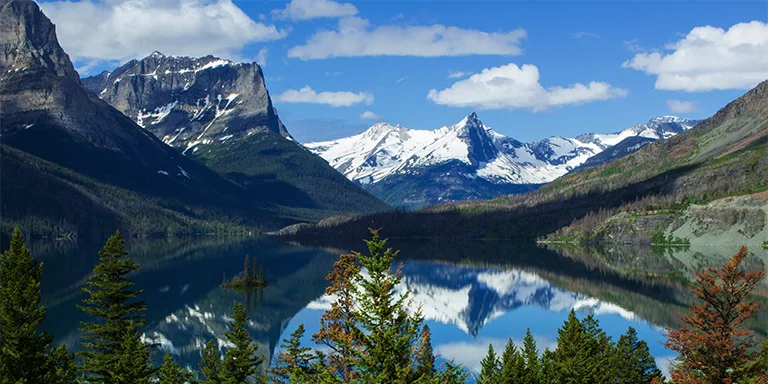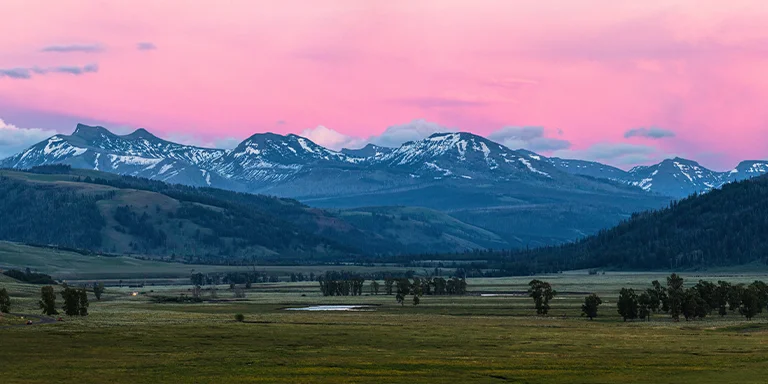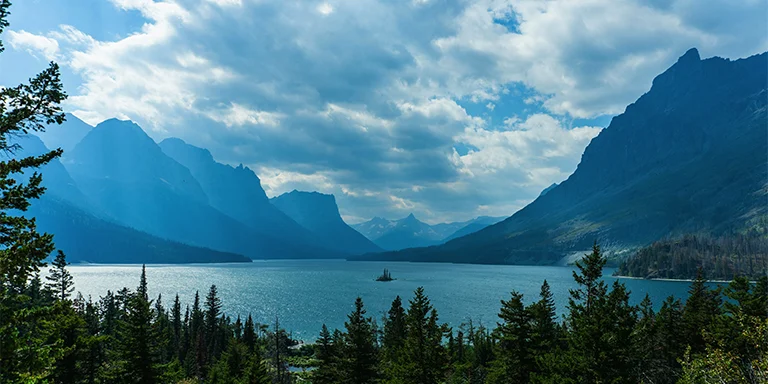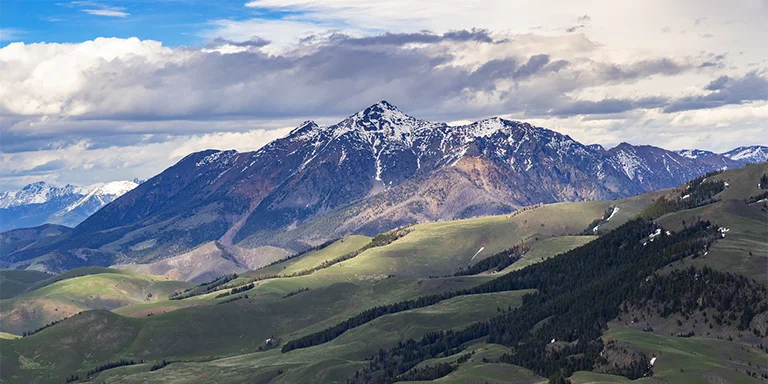

Backpacking in Montana offers immense variety for outdoor enthusiasts, from the rugged peaks of Glacier National Park to the windswept prairies of the Great Plains, including popular destinations like the Bob Marshall Wilderness.
And that’s what this post is all about – backpacking in Montana. We’ll provide tips to help you prepare for backpacking in this diverse state as well as showcase the TOP 5 multi-day trails in Montana.
Interested? Let’s get started.
In our opinion, these are the best multi-day trails Montana has to offer:

Length: 30.8 mi / 49.6 km
Type: Out and back
Difficulty: Hard
Elevation Gain: 5606 ft / 1709 m
Location: Glacier National Park
Estimated Hiking Calorie Burn: 7680 calories
More Details: See on AllTrails
This strenuous 30-mile out-and-back trail to Triple Divide Pass in Glacier National Park is only for experienced backpackers. The rewarding 14+ hour, steep route along streams and past alpine lakes leads to sweeping summit views, wildlife sightings, and wilderness campsites. Though demanding, especially with full packs, the magnificent scenery of glaciated peaks and flower-filled meadows makes this classic Glacier backpacking trail unforgettable. Permit to camp overnight in the wilderness required.

Length: 32.9 mi / 52.9 km
Type: Out and back
Difficulty: Hard
Elevation Gain: 3605 ft / 1099 m
Location: Yellowstone National Park
Estimated Hiking Calorie Burn: 8200 calories
More Details: See on AllTrails
Trek through vast wildflower-strewn meadows and forested river valleys on this demanding 33-mile out-and-back trail near West Yellowstone. Prepare for panoramic views of Yellowstone’s mountain peaks and plunging canyons as you traverse this route, which takes most hikers over 13 hours to complete.
Keep your eyes peeled for Yellowstone’s famous wildlife as you hike, including great herds of bison grazing on the grassy hillsides and lone pronghorn antelope bounding through the sagebrush. Listen for the telltale chirping of ground squirrels and songs of meadowlarks. And be bear aware – this trail passes through prime grizzly habitat. Carry bear spray and make noise to avoid surprise encounters. A fee is required to enter Yellowstone National Park.

Length: 50.4 mi / 81.1 km
Type: Point to point
Difficulty: Hard
Elevation Gain: 10 826 ft / 3300 m
Location: Glacier National Park
Estimated Hiking Calorie Burn: 12 500 calories
More Details: See on AllTrails
This challenging 50-mile loop through Glacier’s stunning Many Glacier region rewards backpackers with alpine vistas, glacial lakes, and wildlife sightings. Traverse high passes, hike through flower-filled valleys, and spend nights at scenic backcountry campsites on this 2 to 5-day adventure. From the rocky Swiftcurrent Pass to the historic Granite Park Chalet, the variety of terrain showcases Glacier’s best. With proper precautions for bears and routefinding in remote sections, the rewards of this iconic backpacking trip will last a lifetime.

Troy Smith, CC BY-SA 2.0, via flickr
Length: 53.5 mi / 86 km
Type: Point to point
Difficulty: Hard
Elevation Gain: 7814 ft / 2382 m
Location: Bob Marshall Wilderness
Estimated Hiking Calorie Burn: 13 300 calories
More Details: See on AllTrails
This demanding 54-mile point-to-point trail near Augusta, Montana leads through scenic mountain landscapes to the remote Chinese Wall in the Bob Marshall Wilderness. Expect challenging terrain, scenic vistas, wildlife sightings, and dispersed backcountry campsites on this multi-day hike, which takes experienced backpackers over 24 hours. While the trail can be crowded at times, the sweeping views and pristine wilderness at the Chinese Wall make this a premier Montana backpacking adventure. Proper preparation for limited water sources in sections and respect for the terrain are key.

Length: 30.9 mi / 49.7 km
Type: Loop
Difficulty: Hard
Elevation Gain: 4284 ft / 1306 m
Location: Custer Gallatin National Forest
Estimated Hiking Calorie Burn: 7700 calories
More Details: See on AllTrails
This scenic 31-mile loop near Bozeman rewards hikers with alpine lakes, waterfalls, and panoramic mountain vistas. The challenging terrain with steep switchbacks takes most hikers over 13 hours to complete but makes for a memorable day hike or overnight trip. While a popular route for its stunning views of the Gallatin Range, quiet moments can be found during the week and earlier in the day. Bring bear spray and plenty of water as you explore this iconic hiking trail near Bozeman. The variety of mountain landscapes encapsulates the beauty of the Montana outdoors.
Montana’s weather varies across seasons:
Before making your gear selection, take a look at the weather statistics for Montana (Missoula):
| Jan | Feb | Mar | Apr | May | Jun | Jul | Aug | Sep | Oct | Nov | Dec | |
|---|---|---|---|---|---|---|---|---|---|---|---|---|
| High °F | 33 | 39 | 50 | 58 | 67 | 75 | 86 | 85 | 73 | 58 | 42 | 31 |
| Low °F | 18 | 21 | 28 | 33 | 40 | 47 | 51 | 50 | 42 | 32 | 25 | 17 |
| Rain/Snow (D*) | 7 | 6 | 7 | 7 | 9 | 9 | 5 | 5 | 5 | 6 | 8 | 8 |
Not sure if Montana is right for you?
Don’t forget to check out our backpacking guides for Idaho and Washington.
When backpacking in Montana, be aware that campfires are limited. In most areas, you can only have fires in established fire rings in specific campgrounds, not in backcountry sites. Some places don’t allow fires at all because of the high risk of wildfires. Instead of fires, use portable stoves for cooking.
When embarking on a backpacking adventure in the beautiful but remote wild areas of Montana, proper preparation and caution are essential. Before leaving the trailhead, check in with land agencies about trail conditions and download maps to stay oriented while exploring nature far from cell service. Pack essential gear like a warm sleeping bag, backpacking stove, navigation tools, and extra food and water. Make noise and stay alert for wildlife like bears on the trail and always carry EPA-approved bear spray, knowing how to use it safely. Follow rules on proper food storage away from camps at night to avoid confrontations. Hiking with others, sharing trip plans, and frequently checking weather will help you travel safely and respectfully through Montana’s majestic landscape. With the right gear and responsible practices, backpackers can enjoy immersing themselves in the scenic wonder of Big Sky Country.
When you come across wildlife in Montana, the best thing to do is keep your distance and avoid interacting. Make noise on the trail to avoid surprising bears, moose, or other animals. Stay alert and don’t get too close for photos. Learn how to use bear spray in case of an attack and when to stand your ground or back away slowly. If you encounter a bear, move out of its way calmly without running. Pay attention to signs like antler rubs and droppings, indicating mountain lion territory. Never feed or chase wildlife. Report aggressive animals to rangers.